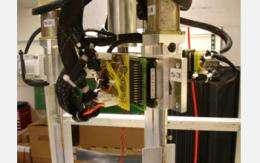On the Crest of Wave Energy

(PhysOrg.com) -- The ocean is a potentially vast source of electric power, yet as engineers test new technologies for capturing it, the devices are plagued by battering storms, limited efficiency, and the need to be tethered to the seafloor.
Now, a team of aerospace engineers is applying the principles that keep airplanes aloft to create a new wave-energy system that is durable, extremely efficient, and can be placed anywhere in the ocean, regardless of depth.
While still in early design stages, computer and scale-model tests of the system suggest higher efficiencies than wind turbines. The system is designed to effectively cancel incoming waves, capturing their energy while flattening them out, providing an added application as a storm-wave breaker.
The researchers, from the U.S. Air Force Academy, will present their design at the 62nd annual meeting of the American Physical Society's Division of Fluid Dynamics on Nov. 24, 2009, in Minneapolis, Minn.
"Our group was working on very basic research on feedback flow control for years," says lead researcher Stefan Siegel, referring to efforts to use sensors and adjustable parts to control how fluids flow around airfoils like wings. "For an airplane, when you control that flow, you better control flight--for example, enabling you to land a plane on a shorter runway."
A colleague had read an article on wave energy in a magazine and mentioned it to Siegel and the other team members, and they realized they could operate a wave energy device using the same feedback control concepts they had been developing.
Supported by a grant from the National Science Foundation, the researchers developed a system that uses lift instead of drag to cause the propeller blades to move.
"Every airplane flies with lift, not with drag," says Siegel. "Compare an old style windmill with a modern one. The new style uses lift and is what made wind energy viable--and it doesn't get shredded in a storm like an old windmill. Fluid dynamics fixed the issue for windmills, and can do the same for wave energy."
Windmills have active controls that turn the blades to compensate for storm winds, eliminating lift when it is a risk, and preventing damage.
The Air Force Academy researchers used the same approach with a hydrofoil (equivalent to an airfoil, but for water) and built it into a cycloidal propeller, a design that emerged in the 1930s and currently propels tugboats, ferries and other highly maneuverable ships.

The researchers changed the propeller orientation from horizontal to vertical, allowing direct interaction with the cyclic, up and down motion of wave energy. The researchers also developed individual control systems for each propeller blade, allowing sophisticated manipulations that maximize (or minimize, in the case of storms) interaction with wave energy.
Ultimately, the goal is to keep the flow direction and blade direction constant, cancelling the incoming wave and using standard gear-driven or direct-drive generators to convert the wave energy into electric energy. A propeller that is exactly out of phase with a wave will cancel that wave and maximize energy output.
The cancellation will also allow the float-mounted devices to function without the need of mooring, important for deep-sea locations that hold tremendous wave energy potential and are currently out of reach for many existing wave energy designs.
While the final device may be as large as 40 meters across, laboratory models are currently less than a meter in diameter. A larger version of the system will be tested next year at NSF's Network for Earthquake Engineering Simulation (NEES) tsunami wave basin at Oregon State University, an important experiment for proving the efficacy of the design.
More information: The abstract is at this link.
Provided by NSF


















